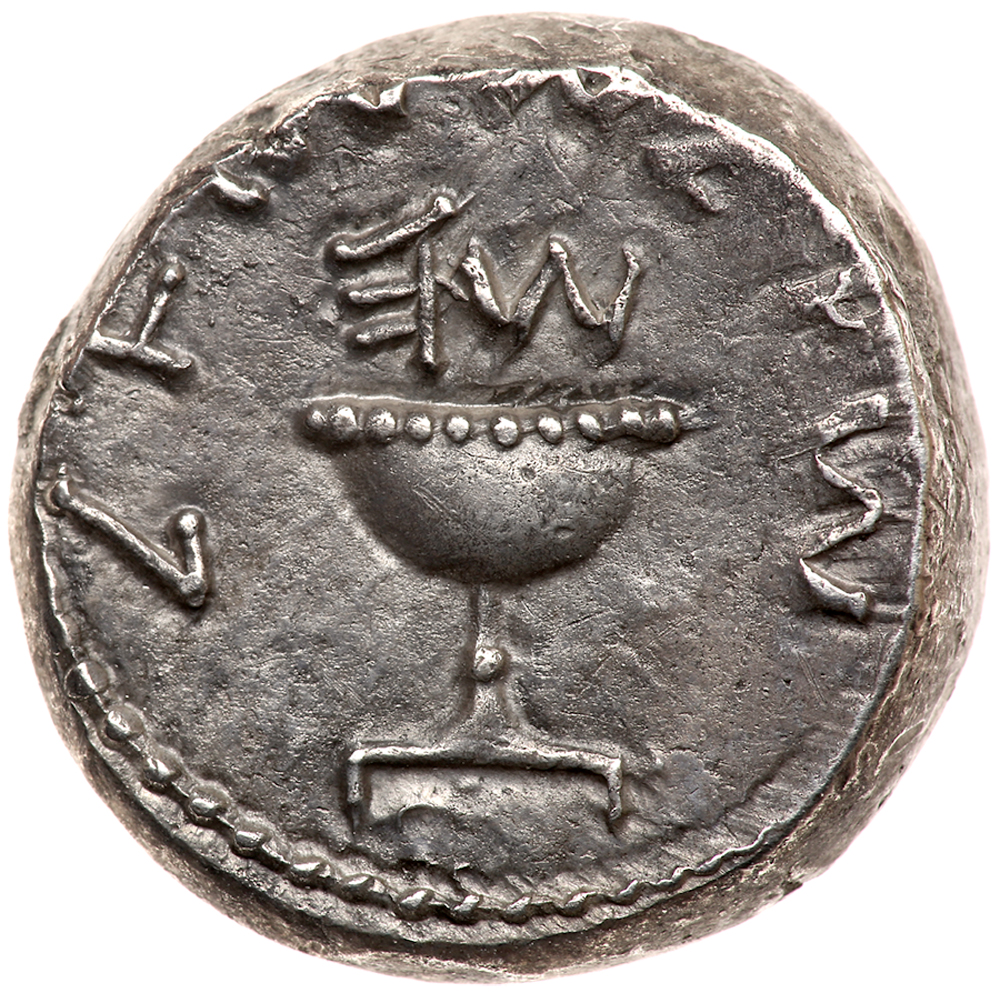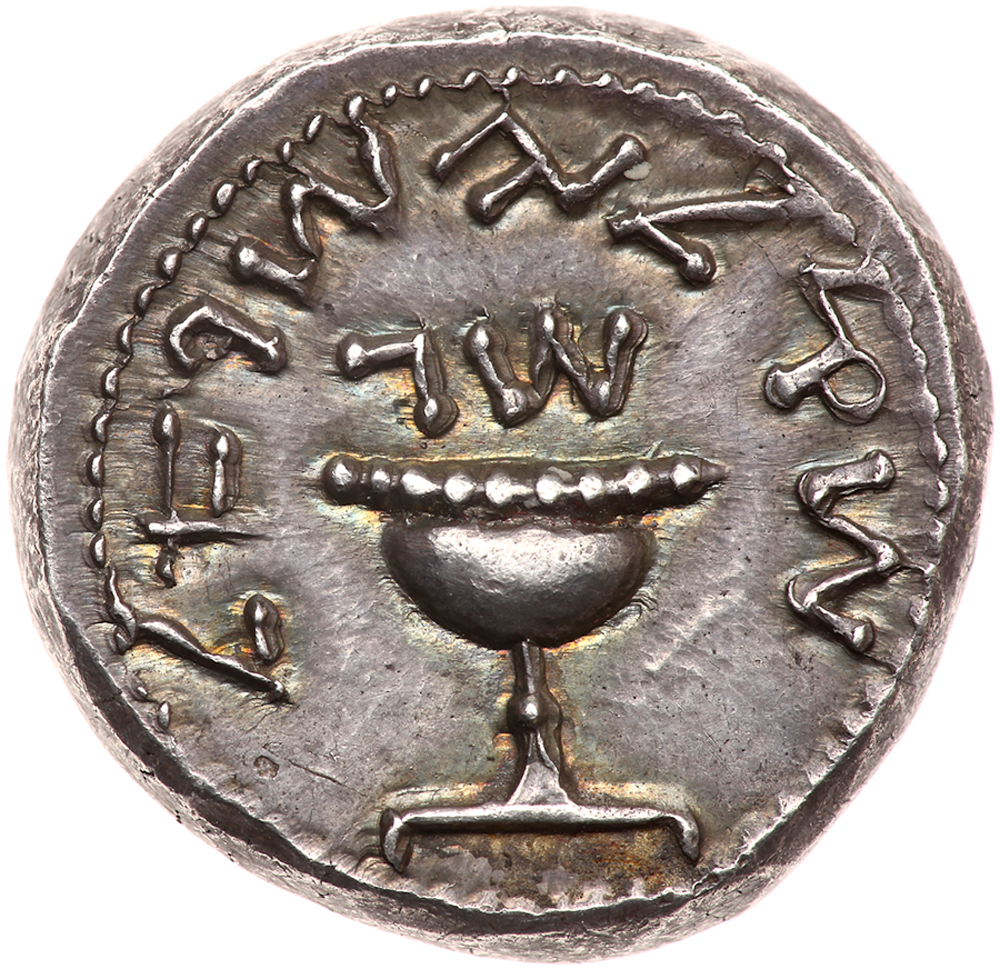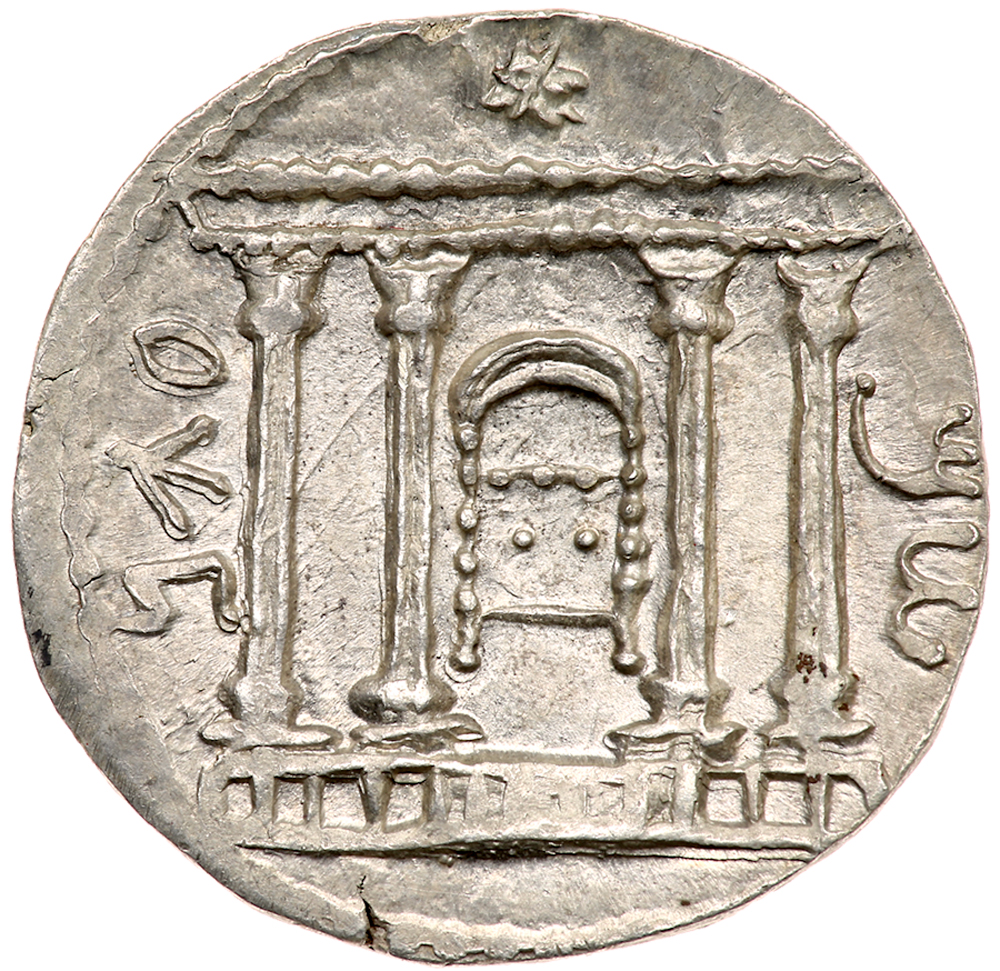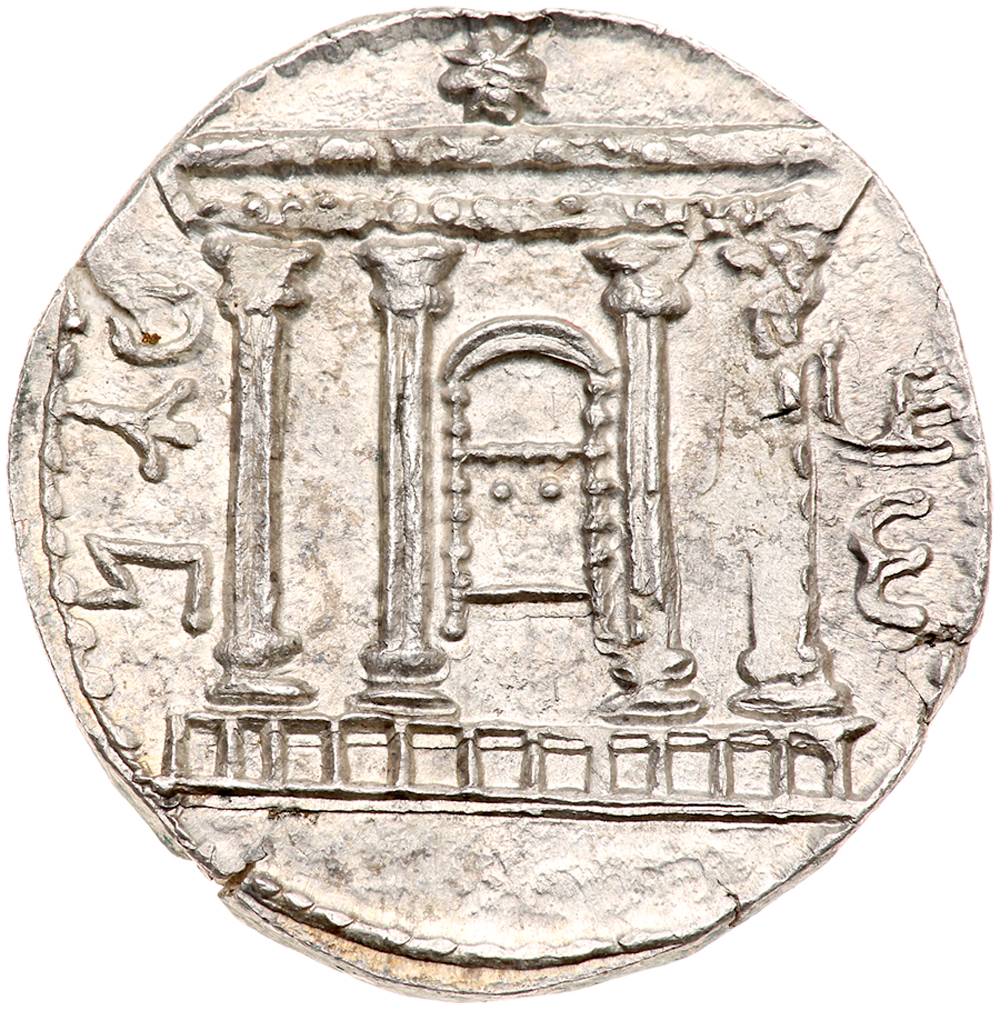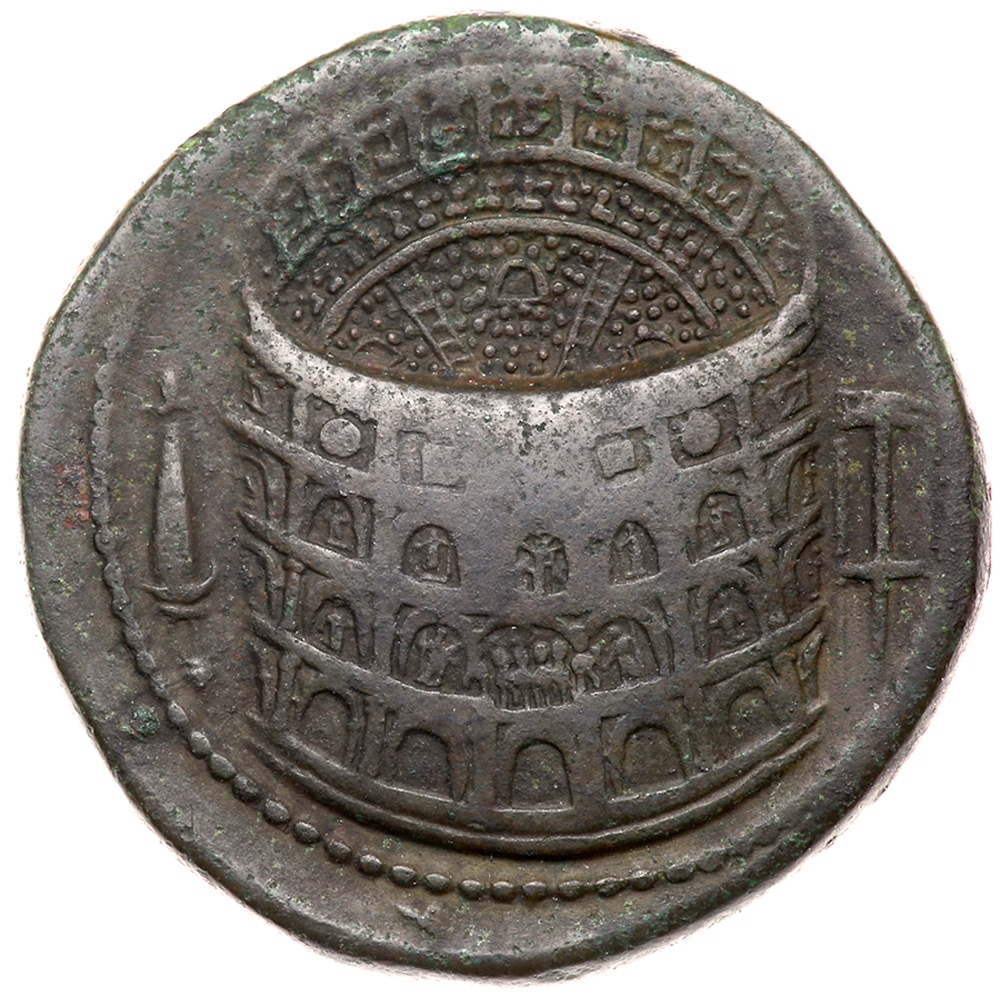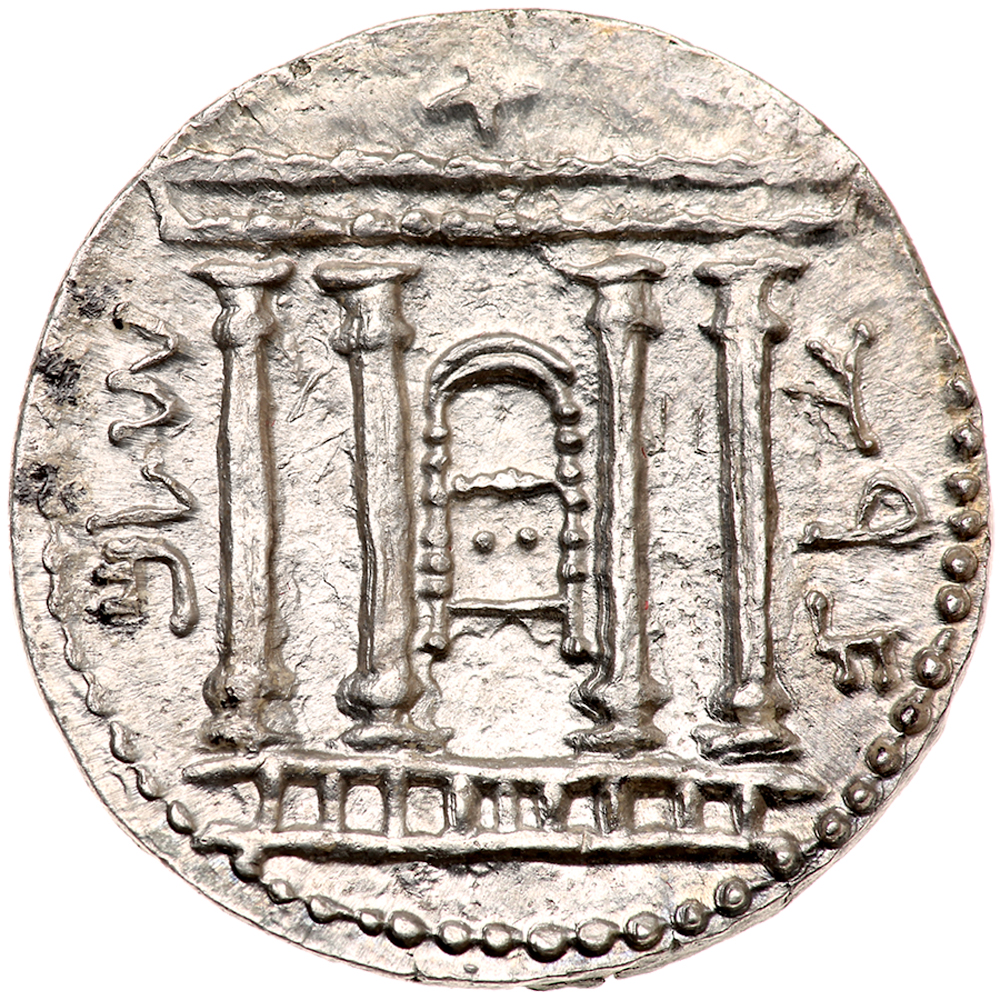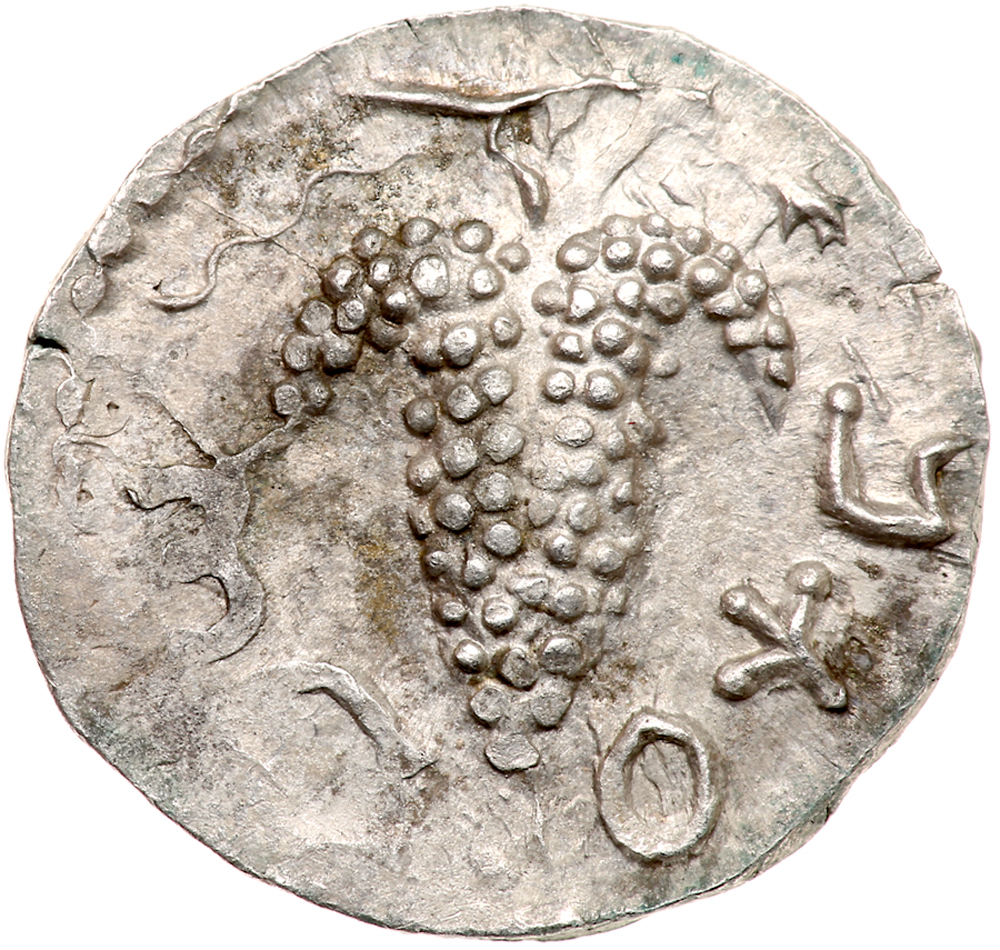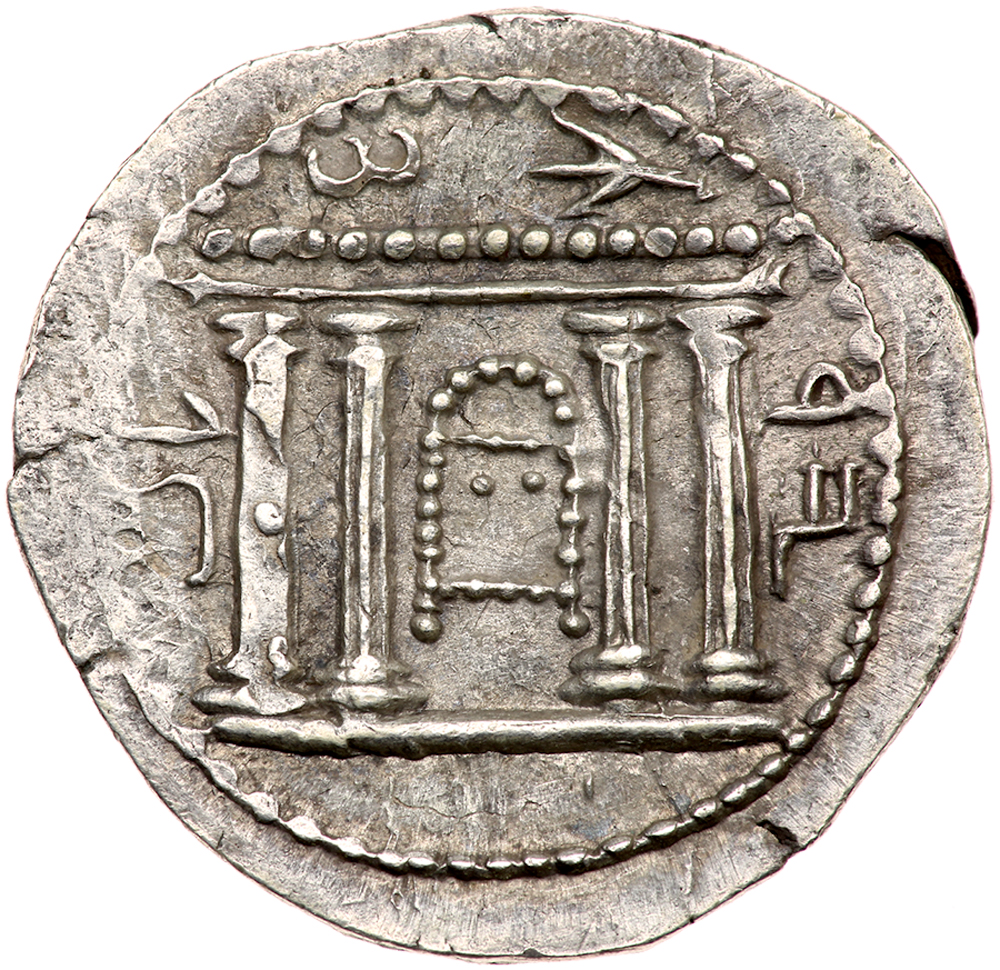Money of the Bible Collection - Coin Auctions
Lot 3009 - Money of the Bible Collection - Ira & Larry Goldberg Coins & Collectibles, Inc. Pre-Long Beach Auction #90Jewish War. Silver Shekel (13.25 g), 66-70 CE. Year 5 (April-Augustus 70 CE). 'Shekel of Israel' around, 'year 5' above, omer cup with pearled rim. Reverse: 'Jerusalem the holy', sprig of three pomegranates. TJC 215; Hendin 1370 (this coin); Menorah Coin Project FJR 16, dies O1/R1 (this coin illustrated). Extremely Rare and of great importance. Lightly toned. Extremely Fine/Very Fine. Ira & Larry Goldberg Coins & Collectibles, Inc. Pre-Long Beach Auction #90Money of the Bible Collection |
|
Lot 3025 - Money of the Bible Collection - Ira & Larry Goldberg Coins & Collectibles, Inc. Pre-Long Beach Auction #90Bar Kochba Revolt. Silver Zuz (3.12 g), 132-135 CE. Year 2 (133/4 CE). 'Shim'on', grape bunch on vine with small leaf and tendril. Reverse: 'Year two of the freedom of Israel', palm branch. Mildeberg 49 (O10/R29); TJC 248; Hendin 1394 corr. (rev. description). Underlying luster present. Extremely Fine. Ira & Larry Goldberg Coins & Collectibles, Inc. Pre-Long Beach Auction #90Money of the Bible Collection |
|
Lot 3036 - Money of the Bible Collection - Ira & Larry Goldberg Coins & Collectibles, Inc. Pre-Long Beach Auction #90Bar Kochba Revolt. Silver Zuz (3.37 g), 132-135 CE. Undated, attributed to year 3 (134/5 CE). 'Shim'on', in two lines within a wreath of thin branches wrapped around eight almonds, medallion at top, and tendrils below. Reverse: 'For the freedom of Jerusalem', elongated lyre with three strings. Mildeberg 70 (O14/R42); TJC 272; Hendin 1419. Extremely Fine. Ira & Larry Goldberg Coins & Collectibles, Inc. Pre-Long Beach Auction #90Money of the Bible Collection |
|
Lot 3004 - Money of the Bible Collection - Ira & Larry Goldberg Coins & Collectibles, Inc. Pre-Long Beach Auction #90Jewish War. Silver Shekel (14.20 g), 66-70 CE. Year 3 (68/9 CE). 'Shekel of Israel' around, 'year 3' above, omer cup with pearled rim. Reverse: 'Jerusalem the holy', sprig of three pomegranates. TJC 202a; Hendin 1361. Well struck on excellent metal with all detail bold and crisp. A magnificent example with incredible natural iridescent toning. This beauty ranks as one of the finest silver shekels we have ever seen! Superb Nearly Mint State. Ira & Larry Goldberg Coins & Collectibles, Inc. Pre-Long Beach Auction #90Money of the Bible Collection |
|
Lot 3020 - Money of the Bible Collection - Ira & Larry Goldberg Coins & Collectibles, Inc. Pre-Long Beach Auction #90Bar Kochba Revolt. Silver Sela (13.65 g), 132-135 CE. Year 2 (133/4 CE). 'Shim'on', tetrastyle facade of the Temple of Jerusalem; Ark of the Covenant in chest form with semicircular lid and short legs, seen from a narrow side; star above. Reverse: 'Year two of the freedom of Israel', lulav with etrog at left. Cf. Mildeberg 38/36 (O8/R26) die combination not recorded; TJC 230; Hendin 1388. Extremely Rare new die combination unknown to Mildenberg. Delicately toned with underlying luster still present. Extremely Fine. Ira & Larry Goldberg Coins & Collectibles, Inc. Pre-Long Beach Auction #90Money of the Bible Collection |
|
Lot 3031 - Money of the Bible Collection - Ira & Larry Goldberg Coins & Collectibles, Inc. Pre-Long Beach Auction #90Bar Kochba Revolt. Silver Sela (14.63 g), 132-135 CE. Undated, attributed to year 3 (134/5 CE). 'Shim'on', tetrastyle facade of the Temple of Jerusalem; Ark of the Covenant in chest form with semicircular lid and short legs, seen from a narrow side; star above. Reverse: 'For the freedom of Israel', lulav with etrog at left. Mildeberg 73 (O11/R42); TJC 267; Hendin 1411. Rare - only five specimens recorded by Mildenberg. Well struck with the lulav in high relief. Underlying luster present. Nearly Mint State. Ira & Larry Goldberg Coins & Collectibles, Inc. Pre-Long Beach Auction #90Money of the Bible Collection |
|
Lot 3047 - Money of the Bible Collection - Ira & Larry Goldberg Coins & Collectibles, Inc. Pre-Long Beach Auction #90Titus. Æ Sestertius (25.87 g), AD 79-81. Rome, AD 80/1. View of the Amphitheatrum Flavium (the Colosseum) between the Meta Sudans, on left, and porticoed building, on right; the exterior of the monument showing four tiers with a varying number of arches, some empty and some with statuary; the interior shows the seating filled with spectators, steps, and the emperor's viewing box. Reverse: IMP T CAES VESP AVG P M TR P P P COS VIII, S C across field, emperor seated left on curule chair, holding branch and scroll; around, various arms. RIC 184; BMC 190, pl. 50, 2 (same dies); BN 189 (same rev. die); Kent-Hirmer pl. 68, 239 (obv. only illus.). Hendin 1594. Very rare and much sought-after as the famous monument of Italy, if not of all antiquity. Struck on a very broad flan, pleasing reddish-brown patina. Choice Very Fine. Ira & Larry Goldberg Coins & Collectibles, Inc. Pre-Long Beach Auction #90Money of the Bible Collection |
|
Lot 3015 - Money of the Bible Collection - Ira & Larry Goldberg Coins & Collectibles, Inc. Pre-Long Beach Auction #90Bar Kochba Revolt. Silver Sela (14.34 g), 132-135 CE. Year 2 (133/4 CE). 'Jerusalem', tetrastyle facade of the Temple of Jerusalem; Ark of the Covenant in chest form with semicircular lid and short legs, seen from a narrow side; star above. Reverse: 'Year two of the freedom of Israel', lulav with etrog at left. Mildeberg 19 (O4/R13); TJC 230; Hendin 1386. Boldly struck with underlying luster present. Lightly toned. Superb Extremely Fine. Ira & Larry Goldberg Coins & Collectibles, Inc. Pre-Long Beach Auction #90Money of the Bible Collection |
|
Lot 3042 - Money of the Bible Collection - Ira & Larry Goldberg Coins & Collectibles, Inc. Pre-Long Beach Auction #90Judaea, Bar Kochba Revolt. Silver Zuz (3.34 g), 132-135 CE. Undated, attributed to year 3 (134/5 CE). 'Shim'on', grape bunch on vine with tendril and small leaf. Reverse: 'For the freedom of Jerusalem', fluted jug with handle on left; no willow branch. Mildeberg 164 (O21/R89); TJC 286; Hendin 1434. Very Fine. Ira & Larry Goldberg Coins & Collectibles, Inc. Pre-Long Beach Auction #90Money of the Bible Collection |
|
Lot 3010 - Money of the Bible Collection - Ira & Larry Goldberg Coins & Collectibles, Inc. Pre-Long Beach Auction #90Bar Kochba Revolt. Silver Sela (14.50 g), 132-135 CE. Year 1 (132/3 CE). 'Jerusalem', tetrastyle facade of the Temple of Jerusalem; Ark of the Covenant in chest form with semicircular lid and short legs, seen from a narrow side. Reverse: 'Year one of the redemption of Israel', lulav with etrog at left. Mildenberg 3 (O1/R3); TJC 218; Hendin 1373. Very rare and an incredibly choice example of this major Judean rarity. Boldly struck on a full flan with nice wide margins on both sides. Superb Extremely Fine. Ira & Larry Goldberg Coins & Collectibles, Inc. Pre-Long Beach Auction #90Money of the Bible Collection |

